Table of Contents

The Basics of PIR Foam and PU Foam
When it comes to insulation materials, PIR foam and PU foam are two popular options. Both of these foams have their own unique properties and characteristics, making them suitable for different applications. In this article, we will explore the key differences between PIR foam and PU foam, helping you make an informed decision for your insulation needs.
1. Composition and Structure
PIR foam, also known as polyisocyanurate foam, is a type of rigid insulation material that is made from a closed-cell structure. It is created by combining a polyol resin with an isocyanate, resulting in a foam that is lightweight and durable. On the other hand, PU foam, or polyurethane foam, is also a type of rigid insulation material that is made by reacting polyols with diisocyanates. PU foam can have an open-cell or closed-cell structure, depending on its intended use.
2. Thermal Conductivity
Thermal conductivity is an important factor to consider when choosing insulation materials. PIR foam has a lower thermal conductivity compared to PU foam, which means it provides better insulation and reduces heat transfer. This makes PIR foam a popular choice for applications where high insulation performance is required, such as in building envelopes and refrigeration systems.
3. Fire Performance
One of the key advantages of PIR foam over PU foam is its superior fire performance. PIR foam has a higher fire resistance and is classified as a Class 1 material, indicating that it has a low contribution to fire. On the other hand, PU foam is considered a combustible material and may contribute to the spread of fire if not properly protected. Therefore, PIR foam is often preferred in applications where fire safety is a concern.
4. Moisture Resistance
When it comes to moisture resistance, both PIR foam and PU foam offer good performance. However, PIR foam has a slight edge in this aspect. PIR foam has a closed-cell structure, which means it is less prone to water absorption and moisture damage. This makes PIR foam suitable for applications in humid environments or areas prone to water exposure.
5. Compressive Strength
PIR foam has a higher compressive strength compared to PU foam. This means that PIR foam can withstand higher loads and is less likely to deform under pressure. This makes PIR foam a suitable choice for applications where load-bearing capacity is important, such as under concrete slabs or in structural insulation panels. PU foam, on the other hand, is more flexible and can be used for applications where some degree of compression is expected.
6. Environmental Impact
When it comes to environmental impact, both PIR foam and PU foam have their pros and cons. PU foam is derived from petrochemicals and can have a higher carbon footprint compared to PIR foam. On the other hand, PIR foam can contain blowing agents that have a high global warming potential. However, both foams can be recycled and reused, reducing their overall environmental impact.
7. Cost
In terms of cost, PU foam is generally more affordable compared to PIR foam. This makes PU foam a popular choice for applications where cost-effectiveness is a priority. However, it is important to consider the long-term benefits and performance of the insulation material when making a decision based solely on cost.
8. Application Areas
PIR foam and PU foam are both versatile insulation materials that find applications in various industries. PIR foam is commonly used in building and construction, including wall insulation, roof insulation, and floor insulation. It is also used in refrigeration and cold storage applications due to its excellent thermal insulation properties. PU foam, on the other hand, is used in a wide range of applications, including insulation for pipes, tanks, doors, windows, and HVAC systems.
9. Installation Process
Both PIR foam and PU foam can be installed using similar techniques. They are typically applied as a liquid or a spray, which then expands and solidifies to form a rigid foam. However, it is important to follow the manufacturer's guidelines and use proper safety precautions when installing these foams.
10. Choosing the Right Foam for Your Needs
When it comes to choosing between PIR foam and PU foam, it is important to consider your specific requirements and the intended application. If you prioritize high thermal performance and fire resistance, PIR foam may be the better choice. On the other hand, if cost-effectiveness and flexibility are important factors, PU foam may be more suitable. It is recommended to consult with insulation experts or manufacturers to determine the best foam for your specific needs.

